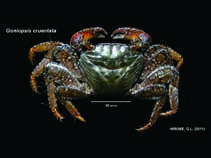Goniopsis cruentata (Latreille, 1802)
Purple mangrove crab| Native range | All suitable habitat | Point map | Year 2050 |

|
| This map was computer-generated and has not yet been reviewed. |
| Goniopsis cruentata AquaMaps Data sources: GBIF OBIS |
Classification / Names Common names | Synonyms | CoL | ITIS | WoRMS
Malacostraca | Decapoda | Grapsidae
Environment: milieu / climate zone / depth range / distribution range Ecology
Benthic; brackish; depth range 0 - 2 m (Ref. 101599). Tropical; 33°N - 30°S, 98°W - 14°E
Distribution Countries | FAO areas | Ecosystems | Occurrences | Introductions
Atlantic Ocean: from Florida to Bermuda, Mexico, Belize, Panama, the Antilles, Colombia, Venezuela, the Guianas, to Brazil (Para to Santa Catarina, including Fernando de Noronha), and the eastern Atlantic, from Senegal to Angola.
Length at first maturity / Size / Weight / Age
Maturity: Lm 2.5, range 2 - 2.9 cm Max length : 5.6 cm CW male/unsexed; (Ref. 102095); 5.1 cm CW (female)
Life cycle and mating behavior Maturity | Reproduction | Spawning | Eggs | Fecundity | Larvae
Main reference
References | Coordinator | Collaborators
Fischer, W., G. Bianchi and W.B. Scott (eds.) 1981 True Crabs. 6: pag.var. In FAO species identification sheets for fishery purposes. Eastern Central Atlantic (fishing areas 34, 47; in part). Canada Funds-in-Trust. Ottawa, Department of Fisheries and Oceans Canada, by arrangement with the Food and AgriculturesOrganization of the United Nations, 1-7: pag.var. (Ref. 435)
IUCN Red List Status
(Ref. 130435: Version 2025-1)
CITES status (Ref. 108899)
CMS (Ref. 116361)
Threat to humans
Human uses
Fisheries: commercial
| FishSource |
Tools
More information
Max. ages / sizes
Length-weight rel.
Length-length rel.
Length-frequencies
Mass conversion
Abundance
Internet sources
BHL | BOLD Systems | CISTI | DiscoverLife | FAO(Publication : search) | Fishipedia | GenBank (genome, nucleotide) | GloBI | Gomexsi | Google Books | Google Scholar | Google | PubMed | Tree of Life | Wikipedia (Go, Search) | Zoological Record



